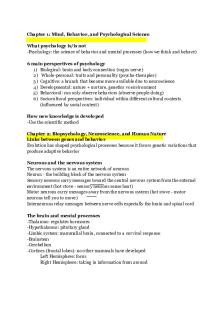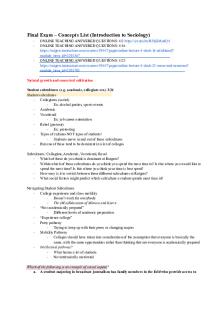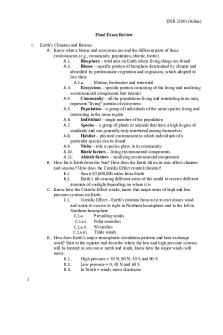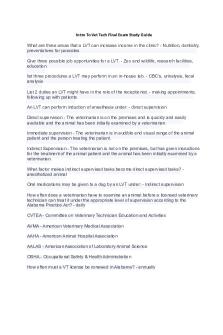Final Exam Study Guide - Summary Intro To Business PDF

| Title | Final Exam Study Guide - Summary Intro To Business |
|---|---|
| Course | Intro To Business |
| Institution | Orange Coast College |
| Pages | 20 |
| File Size | 202.5 KB |
| File Type | |
| Total Downloads | 42 |
| Total Views | 164 |
Summary
Download Final Exam Study Guide - Summary Intro To Business PDF
Description
Final Exam Study Guide 1
Chapter 13 Marketing: 1. The Evolution of Marketing : What marketers do at any time depends on what they need to do to fill customer’s needs & wants - The Production Era: “Produce as much as you can because there is a limitless market for it” - Limited production capabilities & vast demand for products - Logical philosophy - Biz owners were mostly farmers, carpenters & trade workers - The Selling Era: emphasis on selling & advertising (1920’s) - Biz has devlp. mass- production techniques (ex. Assembly lines) - Philosophy turned from producing to selling - Had to persuade customers to buy an existing product - The Marketing Concept Era: Baby boom = consumer spending boom - Competition for the consumer’s dollar was fierce - 1950’s gave birth to marketing concept 2. Three Part of the Marketing Concept - Customer Orientation: find out what customer wants & provide it for them (meeting consumer needs) - Service Orientation: Customer satisfaction, everyone in the organization must be customer - oriented - Profit Orientation: Focus on good & services that will earn most profit & enable organization to expand & survive 3. Customer Relationship Management (CRM) - Process of learning as much as possible about present customer & do everything you can to satisfy them - Enhance customer satisfaction & stimulate long-term customer loyalty 4. The Marketing Mix - Product : Designing a want-satisfying product - Price: Setting a price for the product - Promotion : Putting the product in a place where people will buy it - Distribution: promoting the product 5. Marketing Research A simplified process - Define the question (the problem or opportunity) & determining the present situation - Collecting research data - Analyzing research data - Choosing the best solution & implementing it 6. Primary Data & Primary Sources
Final Exam Study Guide 2
-
Data that you gather yourself, not from secondary sources such as books & magazines - Used to gather more in depth information - More expensive - Ex - telephone surveys, online surveys, personal interviews, focus groups
7. Secondary Data & Secondary Sources - Information that has already been compiled by others & published in journals & books or made available online - The lesser expensive option - First to look @ before collecting primary data 8. Focus Group - A small group of people who meet under the direction of a discussion leader to communicate their opinions about an organization's, its products & other given issues 9. Consumer Market - All the individuals or households that want goods & services for personal consumption or use - Potential market is 7 billion people 10. B2B (Business to Business) Market - Individuals & organizations that want goods & services to use in producing other goods & services or to sell, rent or supply goods to others - Also known as Industrial goods because are used in industry - Ex - cash registers, office desks, display cases business software etc. - The end use of the product is what determines if its B2B - Ex - If a student buys a cup of yogurt then it is a consumer product. If a restaurant buys yogurt to sell to customers, then it is B2B 11. Factors that make B2B Market different 12. Target Marketing - Selecting which groups or segments an organization can serve profitably 13. Demographic - Dividing the market using age, income, & education level - Also religion, race & occupation - Most widely used segmentation variable, but not always the best 14. Psychographic - Dividing the market using groups’ values, attitudes & interests 15. Segmentation
Final Exam Study Guide 3
-
Process of dividing the total market into groups w/ similar characteristics - The best segmentation strategy is to use all the variables to come up w/ a consumer profile that represents a sizable, reachable & profitable taret market
16. Benefit Segmentation - Determining which products benefits your target market & using those benefits to promote a product - Ex - asking why people eat vegetarian food? 18. Volume Segmentation - Separating the market by volume of product used - Ex- who eats vegetarian food more, men or women? 19. Niche Marketing - Identifying small but profitable market segments & designing or finding products for them - Ex- most farmer’s market foods, trampoline parks, doggy sunglasses, 20. 1 to 1 Marketing - Developing a unique mix of goods & services for each individual customer - Ex- travel agents make customer specific packages 21. Mass Marketing - Developing products & promotions to please large groups of people - Little market segmentation - Uses mass media to reach audience such as TV, radio, & newspapers 22. Relationship Marketing - Marketing strategy with the goal of keeping individual customers over time by offering them products that exactly meet their requirements
Chapter 14: Pricing 1. Value
Final Exam Study Guide 4
-
Good quality at a fair price When customers calculate the value of a product, they look at the benefits & then subtract the cost to see of the benefits exceed the cost
2.. Total Product Offer - Everything that consumers evaluate when deciding whether to buy something 3. Distributed Product Development - Handing off various parts of your innovation process (often to companies in other countries) 4. Product Line - A group of products that are physically similar or are intended for a similar market - Often face similar competition - Ex- Nike Golf 5. Product Mix - Combination of product lines offered by a manufacturer - Total of everything the company sells - Ex- Nike & its entirety 6. Product Differentiation - The creation of real or perceived product differences 7. Bundling - Grouping two or more products together and pricing them as a unit - Ex - McDonald’s Happy Meal - Ex - Microsoft Office, phone & Internet package 8. Brand - A name symbol or design (or combo) that identifies the goods or services of one seller or group of sellers & distinguishes them from the competitors 9. Trademark - A brand that has exclusive legal protection for both its brand name and design 10. Manufacturer's Brands - The brand names of manufacturers that distribute products nationally - Ex - Kodak, Sony, & Dell
11. Private Label Brands (aka Dealer Brands) - Products that don’t carry the manufacturer's name but carry a distributor or retailer's
Final Exam Study Guide 5
name instead - Kenmore & DieHard are dealer brands sold by Sears 12. Generic Brands - Non Branded products that usually sell at a sizable discount compared to national or private label brand - Usually sell at a sizable discount compared to national or private label brands - Basic packaging and have little to no advertising - Ex - Aspirin, nylon, zipper 13. Knock Off Brands - Illegal copies of national brand-name goods - Extremely low prices for a normally expensive product - Fake Louis Vuitton purses or Rolex watches 14. Brand Equity - The value of the brand name and associated symbols - Ex - apple & microsoft, Ziplock bags 15. Brand Loyalty - The degree to which customers are satisfied like the brand & are committed to further purchases - Loyal customers are valuable 16. Brand Awareness - How quickly or easily a given brand name comes to mind when a product category is mentioned - Advertising helps with this - Coca-Cola has one the highest brand awareness 17. Brand Association - The linking of a brand to other favorable images - Ex - Mercedes Benz with luxury & wealth - Ex- Air Jordan Shoe & Michael Jordan 18. Brand Manager - A manager who has direct responsibility for one brand or one product line (called a product manager in some places)
19. The Product Life Cycle : A theoretical model of what happens to sales and profits for a product class over time - Introduction : Product first hits the market, $ losses may occur, few competitors - Growth : Sales are increasing, $ very high profits, growing competitors
Final Exam Study Guide 6
-
Maturity : Sales peak, $ declining profits, stable then declining competitors Decline : Falling sales, $ profits may become losses, declining competitors
20. Pricing Objectives : firms may have different ideas in mind when they set prices (ex. Profit, image, market share etc) - Cost Based Pricing - Setting price based on costs - Demand Based Pricing - Competition Based Pricing - Pricing based off what all other competitors are doing, the price can be set at, above or below competitors’ prices - Break Even Analysis - The process used to determine profitability at various levels of sales - Skimming Price Strategy - New product is priced high to make optimum profit while there’s little competition - Penetration Strategy - Product is priced low to attract many customers and discourage competition - Everyday Low Pricing (EDLP) - Prices lower than competitors & then not having any special sales - High - Low Pricing - Setting prices higher than EDLP stores, but having many special sales where the prices are lower than the competitors - Psychological Pricing - Pricing goods & services at price points that make the product appear less expensive than it really is - Ex - selling a house for $299,000 instead of $300,00 - Non- Price Competition -
Chapter 15: Distribution 1. Disintermediation - reduction in the use of intermediaries between producers and consumers, for example by investing directly in the securities market rather than through a bank.
Final Exam Study Guide 7
2. Marketing Intermediaries (Middlemen) - Organizations that assist in moving goods & services from producers to businesses and businesses to consumers 3. Channel of Distribution - Ensure communication flows & the flow of money and title to goods - A whole set of marketing intermediaries that join together to transport and store goods in their path (or channel) from producers to consumers - Intermediaries such as brokers, agents, wholesalers, & retailers 4. Agents/ Brokers - Marketing intermediaries who bring buyers & sellers together & assist in negotiating an exchange but don’t take title to the goods (they never own the goods) - Ex- real estate agent 5. Wholesaler - A marketing intermediary that sells to other organizations 6. Retailer - An organization that sells to consumers 7. Value vs. Cost of Intermediaries - Values: - Intermediaries perform certain marketing tasks (transporting, storing, selling, advertising & relationship building) faster & more cheap than most manufacturers could 8. Retail Distribution Strategies - A retailer is an organization that sells to ultimate consumers (the final stop) - The Basic Distribution Strategies - Intensive - putting products as many places as possible - Selective - choosing only a few stores in a chosen market - Exclusive using only one store in each market area
9. Intensive, Selective & Exclusive Distribution Intensive - putting products as many places as possible - Selective - choosing only a few stores in a chosen market - Exclusive using only one store in each market area 10. Supply Chain (Value Chain) - The sequence of linked activities that must be performed by various organizations to
Final Exam Study Guide 8
move goods from the raw materials to the ultimate consumers 11. Supply Chain Management - The process of managing the movement of raw materials, parts, work in progress, finished goods & related information through all the organizations involved in the supply chain 12. Logistics - Planning, implementing & controlling the physical flow of materials, final goods & related information from points of origin to points of consumption to meet customer requirements at a profit 13. Freight Forwarder - An organization that puts many small shipments together to create a single large shipment that can be transported cost-effectively to the final destination 14. Intermodal Shipping - The use of multiple modes of transportation to complete a single long distance movement of freight
Chapter 16: Promotion 1. Promotion Mix: Using all the promotional tools - Advertising: paid, nonpersonal communication through various media by organizations & individuals who are in some way identified in the advertising message - Personal Selling : The face - to - face presentation & promotion of goods & services - Public Relations / Publicity: info distributed through media without paying
Final Exam Study Guide 9
2. Sales Promotions - The promotional tool that stimulates consumer purchasing & dealer interest by means of short term activities 3. I.M.C (Integrated Marketing Communications) 4. Trade Advertising - Advertising to wholesalers & retailers by manufacturers to encourage them to carry their products 5. Institutional Advertising - Designed to create an attractive image for an organization rather than for a product - I...
Similar Free PDFs

Intro to Biology Exam 2 study guide
- 11 Pages

Intro to Stats Final Study Guide
- 15 Pages

Business Law Final Exam Study Guide
- 42 Pages

Intro To Psych Final Exam
- 24 Pages
Popular Institutions
- Tinajero National High School - Annex
- Politeknik Caltex Riau
- Yokohama City University
- SGT University
- University of Al-Qadisiyah
- Divine Word College of Vigan
- Techniek College Rotterdam
- Universidade de Santiago
- Universiti Teknologi MARA Cawangan Johor Kampus Pasir Gudang
- Poltekkes Kemenkes Yogyakarta
- Baguio City National High School
- Colegio san marcos
- preparatoria uno
- Centro de Bachillerato Tecnológico Industrial y de Servicios No. 107
- Dalian Maritime University
- Quang Trung Secondary School
- Colegio Tecnológico en Informática
- Corporación Regional de Educación Superior
- Grupo CEDVA
- Dar Al Uloom University
- Centro de Estudios Preuniversitarios de la Universidad Nacional de Ingeniería
- 上智大学
- Aakash International School, Nuna Majara
- San Felipe Neri Catholic School
- Kang Chiao International School - New Taipei City
- Misamis Occidental National High School
- Institución Educativa Escuela Normal Juan Ladrilleros
- Kolehiyo ng Pantukan
- Batanes State College
- Instituto Continental
- Sekolah Menengah Kejuruan Kesehatan Kaltara (Tarakan)
- Colegio de La Inmaculada Concepcion - Cebu











